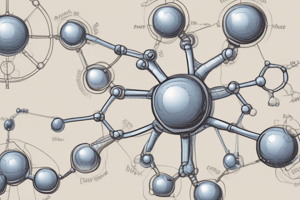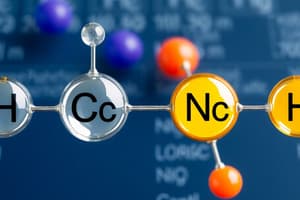Podcast
Questions and Answers
Classify the substance krypton.
Classify the substance krypton.
- Ionic compound
- Molecular element
- Molecular compound
- Atomic element (correct)
Classify the compound CoCl₂.
Classify the compound CoCl₂.
- Ionic compound (correct)
- Molecular compound
- Atomic element
- Molecular element
Classify the substance nitrogen.
Classify the substance nitrogen.
- Ionic compound
- Molecular element (correct)
- Molecular compound
- Atomic element
Classify the compound SO₂.
Classify the compound SO₂.
Classify the compound KNO₃.
Classify the compound KNO₃.
Classify the substance chlorine.
Classify the substance chlorine.
Classify the compound NO.
Classify the compound NO.
Classify the substance sodium.
Classify the substance sodium.
Classify the substance iodine.
Classify the substance iodine.
Classify the substance hydrogen.
Classify the substance hydrogen.
The formula for the ionic compound that forms from aluminum and oxygen is _____.
The formula for the ionic compound that forms from aluminum and oxygen is _____.
The formula for the ionic compound formed from strontium and chlorine is _____.
The formula for the ionic compound formed from strontium and chlorine is _____.
The formula for the compound formed from aluminum and nitrogen is _____.
The formula for the compound formed from aluminum and nitrogen is _____.
The formula for the ionic compound formed from lithium and sulfate ions is _____.
The formula for the ionic compound formed from lithium and sulfate ions is _____.
The compound formed from sodium and sulfur is _____.
The compound formed from sodium and sulfur is _____.
The formula for the compound formed from potassium and acetate is _____.
The formula for the compound formed from potassium and acetate is _____.
Name the compound MgF₂.
Name the compound MgF₂.
Name the compound KBr.
Name the compound KBr.
Name the compound Al₂O₃.
Name the compound Al₂O₃.
Name the compound H₂S(aq).
Name the compound H₂S(aq).
Name the compound HF(aq).
Name the compound HF(aq).
Name the compound HI(aq).
Name the compound HI(aq).
What is the formula mass of carbon tetrachloride (CCl₄)?
What is the formula mass of carbon tetrachloride (CCl₄)?
What is the formula mass of dinitrogen monoxide (N₂O)?
What is the formula mass of dinitrogen monoxide (N₂O)?
Calculate the formula mass of HNO₃.
Calculate the formula mass of HNO₃.
Determine whether the name shown for each molecular compound is correct.
Determine whether the name shown for each molecular compound is correct.
Is HNO₂(aq) an oxyacid or binary acid?
Is HNO₂(aq) an oxyacid or binary acid?
What is the correct name for HClO?
What is the correct name for HClO?
What is the correct formula for sulfurous acid?
What is the correct formula for sulfurous acid?
Determine the formula mass of CaBr₂.
Determine the formula mass of CaBr₂.
Calculate the formula mass for K₂CrO₄.
Calculate the formula mass for K₂CrO₄.
How many chlorine atoms are in three carbon tetrachloride molecules?
How many chlorine atoms are in three carbon tetrachloride molecules?
Flashcards
Molecular Compounds
Molecular Compounds
Consist of two or more different nonmetal atoms bonded together.
Ionic Compounds
Ionic Compounds
Formed from the combination of metal and nonmetal atoms.
Atomic Elements
Atomic Elements
Single atoms that are not bonded to any other atoms.
Molecular Elements
Molecular Elements
Signup and view all the flashcards
Cations
Cations
Signup and view all the flashcards
Anions
Anions
Signup and view all the flashcards
Ionic Compound Formation
Ionic Compound Formation
Signup and view all the flashcards
Charge
Charge
Signup and view all the flashcards
Roman Numerals in Naming
Roman Numerals in Naming
Signup and view all the flashcards
Naming Molecular Compounds
Naming Molecular Compounds
Signup and view all the flashcards
Binary Acids
Binary Acids
Signup and view all the flashcards
Oxyacids
Oxyacids
Signup and view all the flashcards
Atomic Weight
Atomic Weight
Signup and view all the flashcards
Formula Mass
Formula Mass
Signup and view all the flashcards
Isotopes
Isotopes
Signup and view all the flashcards
Isotope Variability
Isotope Variability
Signup and view all the flashcards
Naming Ionic Compounds
Naming Ionic Compounds
Signup and view all the flashcards
Formula Unit
Formula Unit
Signup and view all the flashcards
Oxidation State
Oxidation State
Signup and view all the flashcards
Writing Formulas from Names
Writing Formulas from Names
Signup and view all the flashcards
Acid
Acid
Signup and view all the flashcards
Base
Base
Signup and view all the flashcards
Naming Acids
Naming Acids
Signup and view all the flashcards
Formula Mass
Formula Mass
Signup and view all the flashcards
Atomic Number
Atomic Number
Signup and view all the flashcards
Mass Number
Mass Number
Signup and view all the flashcards
Electrical Conductivity
Electrical Conductivity
Signup and view all the flashcards
States of Matter
States of Matter
Signup and view all the flashcards
Phase Change
Phase Change
Signup and view all the flashcards
Study Notes
Classifying Substances
- Atomic Elements: Single atoms, e.g., krypton, sodium, argon, cobalt.
- Molecular Elements: Diatomic molecules, e.g., nitrogen (N₂), chlorine (Cl₂).
- Molecular Compounds: Composed of two or more nonmetals, e.g., sulfur dioxide (SO₂), carbon disulfide (CS₂).
- Ionic Compounds: Formed from metals and nonmetals, e.g., KNO₃, Na₂O, CrCl₃.
Ionic Compound Formation
- Aluminum and Oxygen: Forms Al₂O₃ with cations (Al³⁺) and anions (O²⁻).
- Strontium and Chlorine: Forms SrCl₂ with cations (Sr²⁺) and anions (Cl⁻).
- Aluminum and Nitrogen: Forms AlN through the combination of Al³⁺ and N³⁻.
- Lithium and Sulfate: Leads to Li₂SO₄ balancing Li⁺ and SO₄²⁻ ions.
Naming Ionic Compounds
- Cation Naming: Identify cation charge to deduce compound name, e.g., MgF₂ is magnesium fluoride.
- Transition Metals: Use Roman numerals for charge indication, e.g., PbCl₄ is lead(IV) chloride, determining lead's charge based on chlorine's contribution.
Molecular Compounds
- Determine names from molecular structure with prefixes indicating the number of each element, e.g., N₂O₄ is dinitrogen tetroxide.
Acid Classification
- Binary Acids: Contain hydrogen and one other element, e.g., HI is hydroiodic acid.
- Oxyacids: Contain hydrogen, oxygen, and another element, e.g., H₂SO₄ is sulfuric acid, derived from sulfate ion.
Formula Mass Calculations
- Calculate mass using atomic weights; for example, the formula mass of carbon tetrachloride (CCl₄) is 153.81 amu from C = 12.01 amu and Cl = 35.45 amu.
Isotope Variability
- CCl₄ Variants: Variations arise from combinations of isotopes of carbon (C-12 and C-13) and chlorine (Cl-35 and Cl-37), leading to different molecular masses.
Common Errors in Naming/Ionic Formulas
- Ensure that compounds are correctly identified as ionic or molecular and that names correspond to the correct formulas and oxidation states. For example, Ca(NO₂)₂ should be named calcium nitrite, not calcium nitrate.
Studying That Suits You
Use AI to generate personalized quizzes and flashcards to suit your learning preferences.
Description
Explore the classification and formation of various ionic compounds in this chemistry quiz. You will learn about atomic elements, molecular compounds, and how to name different ionic compounds accurately. Perfect for students looking to strengthen their understanding of chemistry concepts.



